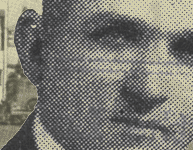 |
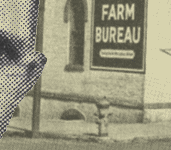 |
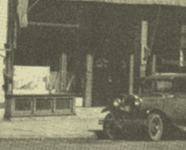 |
|
State
Farm, George Mecherle, |
|
From
Urban Legends to Corporate Urban Legends
/ Illinois Farm Bureau’s Corporate Urban
Legend / Urban legends are so pervasive and popular now there’s an entire show on one of the Discovery Channels dedicated to investigating and debunking urban legends. In fact, just the other day I saw the one about The Choking Doberman. That’s the story where the couple comes home after a late-night party. The husband is really loaded. Their Doberman confronts them at the door, but the dog is choking. The man passes out on the couch and the woman calls the vet at home who agrees to meet her at the clinic. At the suggestion of the vet, the wife drops the dog off and goes back home to take care of her husband. As she goes back into the house the phone rings. It’s the vet who says the dog is okay but she and her husband need to get out of the house immediately. She manages to get herself and her husband out the door just as the police rush to the door along with the vet. The couple is puzzled as the police run into their home. The vet explains to the astonished couple their Doberman was choking on three human fingers. A commotion is heard from the house as the police emerge from an upstairs bedroom with a man bleeding profusely from his hand. Obviously, the intruder had an encounter with the Doberman. On the TV show, the story was analyzed from a practical standpoint and it was determined this urban legend is not true … in fact, it is a story that’s been told in some variation dating back to the Renaissance. There are plenty of these urban legends. Perhaps one of the most well-known urban legend is Alligators in the Sewers of New York City. This story has been around since the 1930s. As the story goes, for years New York City residents would vacation in Florida. Caught up in the spirit of being in Florida, many of these vacationers would buy baby alligators as pets and take them back to New York City. Eventually, the baby alligators would out grow their cute stage and ultimately get flushed down the toilets and into the subterranean sewers. Here’s where the story really morphs … The sewer-ridden alligators mate and eventually evolve into nearly blind albino-like creatures that live in colonies, eat rats, and are periodically spotted by city workers and maintenance people who have to frequent the underground world. Well, the story’s not true. Just from an environmental standpoint the story can’t be true. Alligators require year-round warm weather and could not survive in the New York City sewers during winter. |
|
These urban legends have mutated to the point where there are corporate urban legends … stories about companies or organizations that circulate and are believed to be true when they aren’t. Some of these stories
or urban legends you may have heard: Such as a customer finds mice remains
at the bottom of a Coke bottle, or in a Kentucky Fried Chicken order;
or the myths and inaccuracies surrounding the fraternal order of the Masons
which began to circulate in the 1830s. |
|
You’ve seen
the logo: man in the moon with 13 stars. However, P and G does
not use the trademark as prevalently on every product like it used to.
So this corporate urban legend did have some negative impact on Proctor
and Gamble’s image, and proved expensive to fix. |
|
|
Well, Illinois Farm Bureau
has its own corporate urban legend. It involves George Mecherle, the founder
of State Farm Mutual Automobile Insurance Company. About a year later
in 1982 I began my career at Illinois Farm Bureau. One of the first stories
I heard about Farm Bureau’s history was about George Mecherle. |
|
|
Mecherle was known
as a very progressive and scientific farmer. However, in 1919 he quit
farming and moved to Florida to improve his wife’s health —
she had rheumatoid arthritis. The warm climate did not improve her health
so they moved back to Central Illinois in 1921. |
|
|
In
the spring of 1921, Tazewell County Farm Bureau organizes a township mutual
insurance company — which is the idea Mecherle has been considering
— a mutual insurance company which is owned by those who are insured
through a membership. The Tazewell company was set up to insure property,
including automobiles. “members of Farm Bureau, members of farm mutuals, their immediate families, or those eligible for membership in such organizations.” The association enthusiastically
endorses the plan, and Mecherle proceeds to get the state license he needs
to operate. On June 8, 1922, — the day after George Mecherle’s
45th birthday — State Farm Mutual Automobile Insurance Company is
in business. |
|
| Mecherle
moves his office into the McLean County Farm Bureau Building near downtown
Bloomington in October of 1922. For two years Mecherle’s “honest insurance company” has phenomenal growth as he and a couple other fieldmen sell affordable auto insurance to farmers throughout the state. The operation required more office space than available at the McLean County Farm Bureau building so in 1924 State Farm moved to the Durley Building at 102 East Jefferson in Bloomington. |
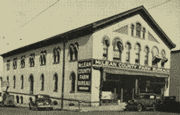 State Farm’s third office was located from 1922-24 in the McLean County Farm Bureau Building which was located on the northeast corner of Monroe and Center Streets in Bloomington. |
| So what’s
going on at Illinois Farm Bureau while George Mecherle is getting his “honest
insurance company” started? In 1924, after solidifying its income
source in 1919, Illinois Farm Bureau began to venture into its own business
activities. Early in 1924 what is now known as the Illinois Agricultural Auditing Association is formed by Illinois Farm Bureau, and Vernon Vaniman is hired as fieldman. Also in 1924 Illinois Farm Bureau formed the Serum Association to begin the fifty-year battle to eradicate hog cholera in Illinois.
During this period many county Farm Bureaus were following Tazewell county
Farm Bureau’s path and forming township mutual insurance companies
to insure Farm Bureau members’ property. |
| In
the meantime, State Farm customers on the eastern side of the state along
the Wabash River who have friends and acquaintances in Indiana are bragging
to their Indiana neighbors about the quality and service from this newly
formed insurance company. Indiana Farm Bureau officials get wind of this
company and in the summer of 1924 send a delegation to Bloomington to meet
with George Mecherle to see if State Farm Insurance may be a good service
to offer Indiana Farm Bureau members.
In November of 1924, Indiana Farm Bureau and State Farm sign a contract
that makes Indiana Farm Bureau the first state agent for State Farm. The
Indiana Farm Bureau director of organization, Harold Nevins, is hired
by Mecherle to become Indiana State Director for State Farm while he maintains
his Indiana Farm Bureau position (Mr. Nevins got very rich). State Farm
begins selling insurance in Indiana in April 1925. |
||||
| During this period many of the state Farm Bureau organizations throughout the country were having terrible financial challenges similar to what IFB faced in 1919. The organization secretary for the South Dakota Farm Bureau, A.W. Tompkins, thought an arrangement with State Farm similar to what Indiana Farm Bureau had arranged would be a good way to improve the South Dakota State Farm Bureau’s finances. Tompkins invites George to the South Dakota Farm Bureau annual meeting in the fall of 1925 to present his plan. Later, in December, South Dakota Farm Bureau becomes the second state Farm Bureau to become a licensed agent to sell State Farm Insurance. |
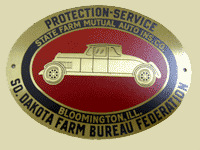 License plate topper from 1930s (or earlier). License plate toppers were a popular form of advertising. This one advertises the partnership between State Farm and South Dakota Farm Bureau. |
|||
|
Meanwhile
at Illinois Farm Bureau, in November of 1925, IFB formed the IAA Farmers
Mutual Reinsurance Company. This action was taken based upon the 1924
recommendation of Illinois Farm Bureau’s Insurance Committee under
the leadership of George Tullock, an IFB Board member from Rockford. The
company was organized and chartered to help spread the fire insurance
risk for the hundreds of township mutual farmer insurance companies around
the state affiliated with county Farm Bureaus. “if IAA enters into the field of auto insurance it will start its own company.” |
||||
| Two months later the IFB Board met in Chicago with county Farm Bureau presidents who unanimously authorized the establishment of the Illinois Agricultural Mutual Insurance Company. Vernon Vaniman was given the assignment to get 3000 advance pledges. By early 1927 he has 3290 and on April 27, 1927, the IAA’s insurance company is chartered. J.P. Gibson is hired as manager but is soon replaced by Ara E. Richardson. Richardson had a history with both Farm Bureau and State Farm. At one time he had worked for IFB membership organizer, J.C. Sailor, as a membership recruiter. Richardson had also worked for the Pure Milk Association. It is also noted in the IAA Record that Ara Richardson helped George Mecherle organize State Farm Mutual Insurance Company. However, there are no references to Richardson in State Farm historical materials available to the public. Richardson remained with IAA Insurance until his retirement in 1953. | ||||
 Vernon Vaniman was the first fieldman for Illinois Agricultural Auditing Association, Illinois Farm Bureau’s oldest affiliate. When IFB started its first automobile insurance company in 1927, Vaniman was given the assignment to recruit 3000 new insurance customers — he topped his goals at 3290. |
|
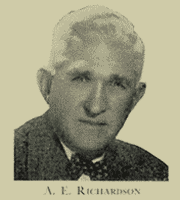 A.E. Richardson at his retirement in 1953. At the conclusion of his 26-year career, he was manager of Country Life Insurance Company as well as a director of IAA Insurance Service. |
||
While Illinois Farm Bureau is organizing its own insurance company, in the spring of 1927, Iowa Farm Bureau approaches State Farm and sets up the same arrangement as Indiana. Shortly after that, upon invitation from the state Farm Bureaus, Mecherle moves into Colorado, Kansas, Kentucky, and Nebraska. In 1928, Mecherle continues his state Farm Bureau partnerships and moves into California, Mississippi, Montana, Nevada, Texas, Utah, and Washington. After nearly a year of discussions, in February of 1929, IFB organizes Country Life Insurance Company. Meanwhile State Farm marches into Arizona, Idaho, New Mexico, West Virginia, and Wyoming, with blessings of the appropriate state Farm Bureau.State Farm moved into North Carolina, Oklahoma, Oregon, and Virginia in 1930, and Maryland in 1933. Shortly after this state Farm Bureaus began to form their own insurance companies based upon the Illinois model. And those states that struck the bargain with State Farm maintained that relationship into the 1940s and 50s. Eventually, many of these state Farm Bureaus also started their own insurance companies. |
|
| The
cleverness of State Farm’s growth and expansion cannot be denied.
However, it’s worth wondering if the grassroots infrastructure the
state Farm Bureaus offered had not been as accessible to Mecherle, would
State Farm had grown as quickly as it did? Probably not, but the relationship
was symbiotic. There were mutual benefits — no pun intended. Mecherle
got the customers he needed, and the state Farm Bureaus got the cash they
needed to keep their organizations viable and able to continue to serve
their farmer members. I would say the State Farm/Illinois Farm Bureau story should be heralded and held up as an example of what a bunch of smart farmers can do once they set their minds to it. It’s interesting two great organizations that serve farmers well grew from the fertile fields of Central Illinois. |
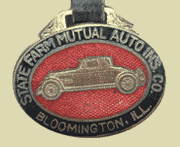 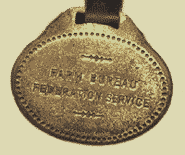 This very rare watch fob advertises State Farm, but on the reverse side is the stamp of endorsement by the Farm Bureau Federation Service. |
| Illinois
Farm Bureau and State Farm Mutual Automobile Insurance Company Early History Timeline |
|
SF 1900-1918 George Mecherle’s career as an independent farmer; considered a very progressive and smart farmer; was an early adopter of scientific methods.
IFB 1916 Illinois Agricultural Association/IAA (Illinois Farm Bureau) organizes in January and March.
IFB 1919 Illinois Farm Bureau reorganizes in Peoria with a sound financing plan.
SF 1919-1921 George Mecherle moves to Florida for wife’s health; returns to McLean County and sells insurance, and then tractors. Considers starting his own insurance company — “an honest insurance company.”
IFB 1920 Farm Depression begins.
IFB 1921 IFB moves to 608 South Dearborn offices in Chicago and stays there until 1947.
SF 1921 George Mecherle meets his future business partner, Minnie A. Jones, who works for a Bloomington insurance company (the one Mecherle worked for). She is smart and an expert in insurance office management and details.
IFB 1921 (April 1) Tazewell County Farm Bureau members organize a township mutual auto insurance company to serve Tazewell County Farm Bureau members — which is what Mecherle has in mind — use the farmer’s mutual concept (owned by the insured via a membership) which had been around since the mid 1800s.
SF
1921 (summer) Mecherle attends the meeting of
the Federation of Mutual Fire Insurance Companies meeting in St. Louis.
Talks with Tazewell County Farm Bureau officials which helps
Mecherle “crystallize” his idea.
SF 1921 Opens first temporary office in the Illinois House in Bloomington.
SF 1921 (October-November) Mecherle meets with attorney Ekern and exchanges letters. Ekern is very critical of the plan and helps Mecherle refine his plan.
SF 1921 (late November) Mecherle meets with Ekern’s law partner, Erwin A. Meyers who agrees to handle the legal work to help the company get a state license.
SF 1922 (January) A prospectus is developed and presented at the meeting of the Illinois State Association of Mutual Insurance Companies (primarily farm mutuals) in Streator. The plan is endorsed. Mecherle’s plan will sell automobile insurance to “members of Farm Bureau, members of Farm Mutuals, their immediate families, or those eligible for membership in such organizations."
SF 1922 (March) To raise the $20,000 for the state-required “certificate of deposit,” G.J. Mecherle, Inc. is established to manage the affairs of State Farm Mutual Automobile Insurance Company. Investors are Mecherle (60%) and Miss Minnie Jones (30%) and her sister (10%). The Board is Mecherle, Jones, and attorney Meyers.
SF 1922 (Spring) Offices move to the Durley Building at 102 East Jefferson in Bloomington.
SF 1922 (April) Prairie Farmer prints its first State Farm Insurance Ad.
SF 1922 (June 8 — day after Mecherle’s 45th birthday) State issues license to State Farm Mutual Automobile Insurance Company and permanent board of directors is elected.
SF 1922 (October) Office moves into the McLean County Farm Bureau office near downtown Bloomington.
IFB 1923 Sam Thompson is elected IFB president.
SF
1923 (October) Miss Minnie Jones resigns from State Farm as office
manager, secretary, treasurer, and partner due to conflicts with Mecherle.
IFB 1924 What is now IAAA (Illinois Agricultural Auditing Association) is organized as Illinois Agricultural Cooperative Association. Vernon Vaniman of Virden is hired as fieldman, and George Wicker of Minnesota is hired as manager.
IFB 1924 Illinois Farm Bureau Serum Association organizes.
IFB 1924 Illinois Farm Bureau board meets with Mecherle to discuss buying him out. Some IFB officials want IFB to start its own automobile insurance company. Mecherle suggested (and it was accepted) that the county Farm Bureau Advisors become authorized agents to sell State Farm Insurance to FB members on a commission basis.
SF 1924 Office moves back to the Durley Building.
SF 1924 (Summer) Indiana Farm Bureau officials send a study committee to Bloomington to meet with Mecherle to see if State Farm Auto Insurance may be a good service to offer Indiana Farm Bureau members.
SF 1924 (November 22) Indiana Farm Bureau and State Farm sign a contract making the Indiana Farm Bureau the first state agent for State Farm. Indiana Farm Bureau director of organization, Harold Nevins, keeps his Farm Bureau job but also becomes Indiana State Director for State Farm.
SF 1925 (April 9) State Farm begins selling insurance to Indiana Farm Bureau members.
IFB 1925 Sam Thompson is elected president of American Farm Bureau Federation.
SF 1925 (Late Summer/Early Fall) Mecherle invited to South Dakota Farm Bureau annual meeting to present his ideas. The organization’s secretary A.W. Tompkins saw a partnership with State Farm as a way to infuse much needed cash into the operations of the struggling state Farm Bureau.
IFB 1925 (November 17) Based upon the 1924 recommendations of the IAA Insurance Committee of the IFB Board chaired by IFB Director, George F. Tullock of Rockford, the Farmers Mutual Reinsurance Company is organized and chartered to help spread the fire insurance risk of the township mutual farmer insurance companies around the state.
SF 1925 (December 5) South Dakota Farm Bureau Federation becomes a state agent for State Farm (like Indiana).
SF 1925 (December 8) Missouri Farm Bureau Federation becomes a state agent for State Farm (was also seen as a way to rescue the struggling Federation).
SF 1926 Minnesota Farm Bureau becomes a state agent for State Farm, which financially rescues the Farm Bureau.
SF 1926 Michigan Farm Bureau becomes a state agent for State Farm.
IFB 1926 (January 21) Earl C. Smith is elected IFB president.
IFB 1926 (June - July) The executive committee of IFB authorizes IFB to “investigate the advisability of theft, life, and automobile insurance for its members.”
SF 1926 North Dakota Farm Bureau becomes a state agent of State Farm Mutual Automobile Insurance Company (needs cash, badly).
IFB 1926 (September) Mecherle meets with IFB Board and presents facts and figures about State Farm and cited the advantages of IFB offering members State Farm Insurance (similar to the arrangement set up in Indiana). After hearing Mecherle, the IFB executive committee decides “if IAA enters into the field of auto insurance, it will start its own company.”
IFB 1926 (October 8) County Farm Bureau presidents meet in Chicago with the IAA Executive Committee and vote unanimously to set up an automobile insurance company. Vernon Vaniman is assigned the job of getting advance orders for the new auto insurance product and he gets 3290 initial pledges/applications.
IFB 1927 (March 7) Illinois Farm Supply is organized.
SF 1927 Iowa Farm Bureau Federation approaches State Farm and establishes the same relationship that had been established with the Indiana Farm Bureau.
SF 1927 With an invitation from state Farm Bureaus, State Farm Mutual moves into Colorado, Kansas, Kentucky, and Nebraska.
IFB 1927 (April 27) Illinois Agricultural Mutual Insurance Company is chartered. J.P. Gibson hired as manager, and is succeeded by Ara E. Richardson who helped organize State Farm Mutual Automobile Insurance Company. Previously he had worked for J.C. Sailor (of IFB) as membership solicitor, and was also with the Pure Milk Association.
IFB 1927 Discussions at IFB Annual Meeting to set up a life insurance company.
IFB 1928 IFB Board authorizes the establishment of a life insurance company.
IFB 1928 (December) County Farm Bureau presidents approve the establishment of a life insurance company.
SF 1928 With the invitation of the state Farm Bureaus, State Farm moves into California, Mississippi, Montana, Nevada, Texas, Utah, and Washington.
IFB 1929 (February) Country Life Insurance Company issues its first policy.
SF 1929 With an invitation from the state Farm Bureaus, State Farm moves into Arizona, Idaho, New Mexico, West Virginia, and Wyoming.
SF 1930 With the invitation of the state Farm Bureaus, State Farm moves into North Carolina, Oklahoma, Oregon, and Virginia.
SF 1933 Mecherle and his son (Ermond) tour several states in an effort to get State Farm licenses to do business in those states. Maryland Farm Bureau files a petition with the Maryland Insurance Department that objects to State Farm’s entrance to the state. Two “unfriendly” agents of the Virginia Farm Bureau testify negatively about State Farm during the Maryland hearing. State Farm gets a license to sell insurance in Maryland.
Many of the early employees of the various state Farm Bureaus who helped State Farm expand into their states often ended up working for George Mecherle and had long and successful careers at State Farm. From: The Farmer From Merna (A Biography of George J. Mecherle, and History of State Farm Mutual Automobile Insurance Company) by Karl Schriftgiesser; Chapter 7; 1955
“When the history of the American Farm Bureau Federation is written it will be incomplete without a chapter on its close relationship on the state level — especially in the late 1920s and early 1930s — with State Farm Mutual. In the early days in Illinois George Mecherle and his little “gang” of mud-lane salesmen sought those who were members or eligible to be members of that far-flung organization. But it was not until the first out-of-state contract was signed by State Farm and the Indiana Farm Bureau Federation that the connection became, as it were, official. From then, as the company’s expansion grew, it became so close that, in the eyes of many, State Farm and Farm Bureau were one and the same.”
“That it (the relationship between State Farm and Farm Bureau) worked, as the Indiana pioneers had predicted and intended that it would, for the benefit of both, is a matter of history. That, in the early days, State Farm was of considerable economic help to the Farm Bureau, especially during the years of agricultural depression, is also a matter of history.”
“In most instances, where entrance (of State
Farm into a state) had been facilitated by Farm Bureau sponsorship and contract, the relationship
lasted ten or twenty years. Then many of these Farm
Bureaus set up automobile insurance companies under their own control and supervision. Invariably From: The Farm Bureau Through the Decades by Orville Merton Kile; 1948.
“Within two years after AFBF was organized, automobile casualty insurance became an important source of revenue to a number of state farm bureaus, as well as an inducement that could be used in soliciting memberships. Mr. George Mecherle of Bloomington, Illinois was the leading, practical pioneer in this activity. He organized the State Farm Mutual Insurance Company at Bloomington in 1922. A contract was developed whereby the state farm bureau would assist in securing policies from its members and in return would receive a definite fee or payment for each policy. In addition the farmer would get his insurance at a lower rate. The plan worked very well, was financially successful, and contracts of this general character are still in effect with several state farm bureaus.” (in 1948) page 347
“With the earlier (insurance) companies (started by state Farm Bureaus) the pattern of development was usually similar to the program evolved in Illinois worked out in large measure by General Counsel Donald Kirkpatrick. It called for a mutual company, owned by its policy holders and limited to members of the Farm Bureau in the home state.” Page 349 All information gathered for this timeline came from the pages of the IAA Record and from The Farmer From Merna. |